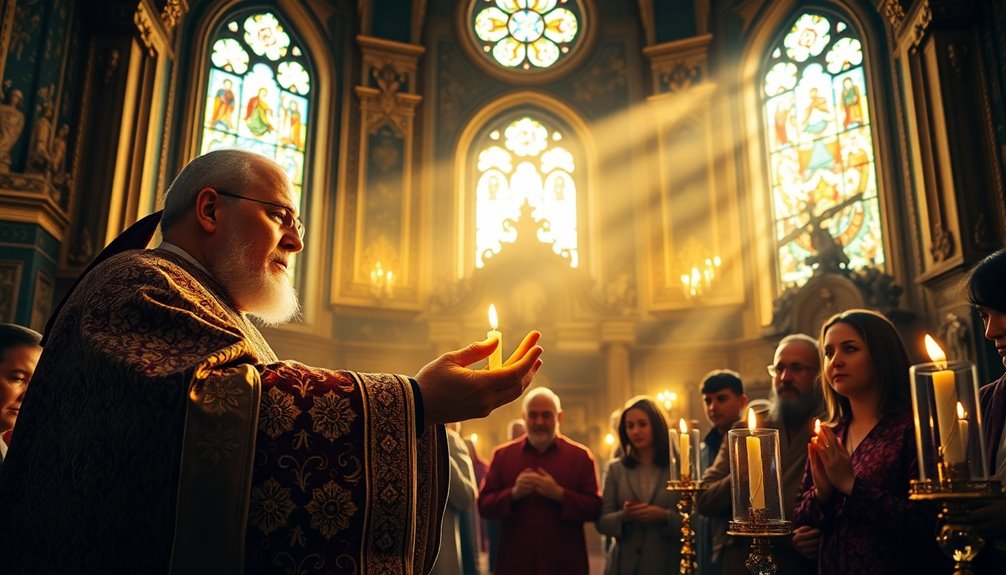An Orthodox blessing is a sacred act where a priest invokes God's grace upon people or objects. It's a deep-rooted tradition, reflecting gratitude and connection to the divine. Different types of blessings, like those for baptisms or homes, seek protection and spiritual nourishment. During these rituals, the priest symbolizes Christ, enhancing the congregation's reverence. Each blessing acts as a reminder of God's presence in daily life, helping to build community and foster faith. If you're curious about the various forms and meanings of these blessings, you'll discover even more fascinating insights on this subject.
Key Takeaways
- Orthodox blessings invoke God's grace upon people and objects, reflecting the Church's spiritual commitment and tradition.
- They can be for various purposes, including objects, places, individuals, and special events, emphasizing gratitude and divine protection.
- Blessings act as intercessory prayers, inviting divine intervention and fostering community through shared sacred rituals.
- Rituals, often led by clergy, symbolize the intertwining of daily life with the sacred, reinforcing the presence of God in everyday situations.
- Iconography plays a vital role, serving as spiritual windows that deepen faith and enhance the blessing experience through veneration.
Overview of Orthodox Blessings
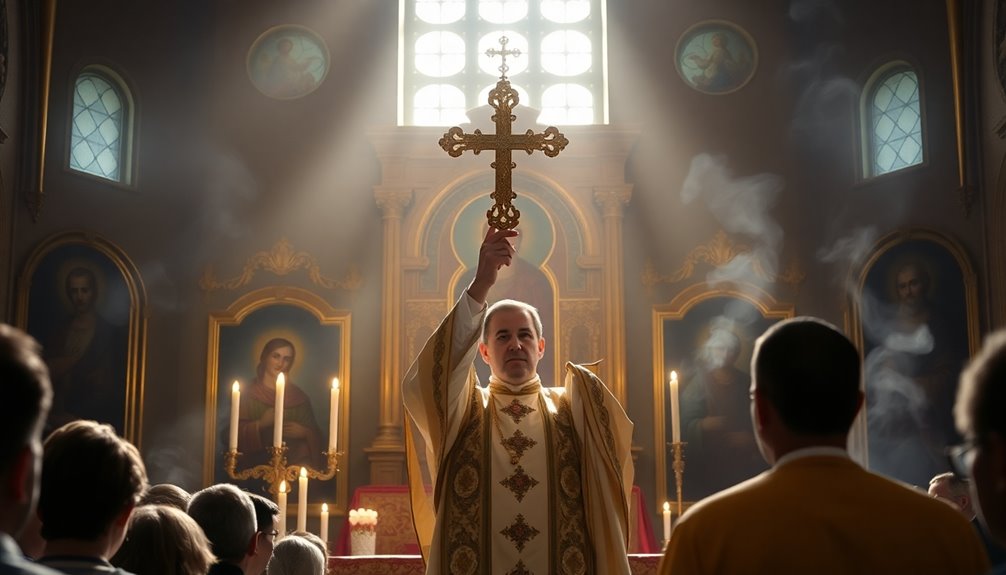
Orthodox blessings play a significant role in the spiritual life of the Church, serving as a powerful means to invoke God's grace upon people and material things. They carry substantial weight, much like how harmful words can inflict damage.
When you receive a blessing, know it's spoken with intention and purpose, rooted in Scripture and tradition. Material objects, like water and icons, can become holy when set aside for divine purposes, reminding you of God's creative power in everyday life.
Priests, through their unique ordination, symbolize Christ during blessings, inviting reverence from the congregation. By participating in these sacred rituals, you partner with God, expressing gratitude and fostering a sense of community, all while reaffirming that every blessing ultimately leads back to Him.
Different Types of Blessings
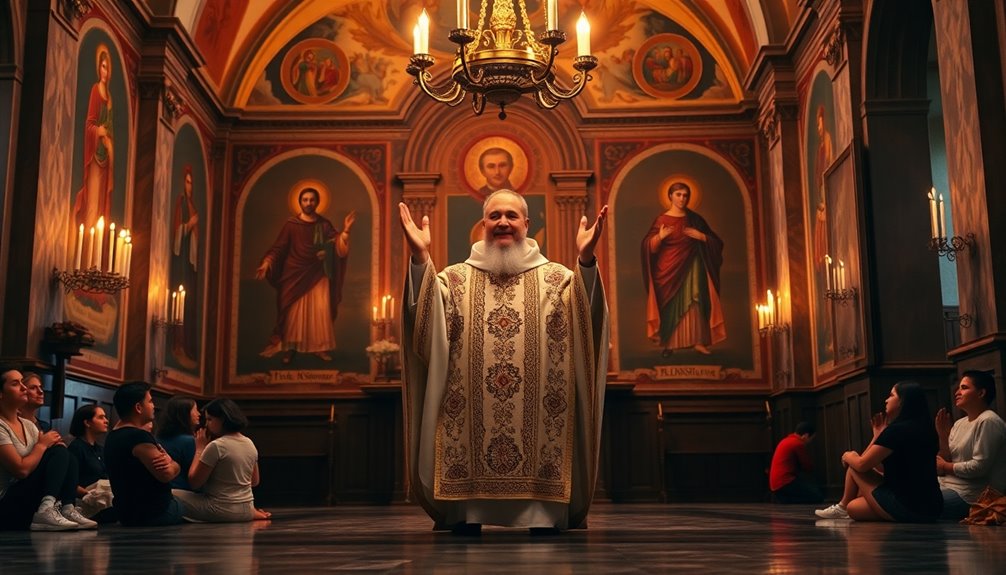
Blessings in the Orthodox tradition encompass a variety of sacred acts that touch both the physical and spiritual domains.
You might encounter blessings for objects and places, like icons, churches, and food, which express gratitude and sanctify items for worship. Individual blessings, such as baptism and blessings for journeys, seek God's protection and guidance.
Liturgical blessings, including the final benediction after the Divine Liturgy, invoke God's mercy for the community. Special services, like the Great Blessing of Water during Epiphany, commemorate significant events in faith.
Additionally, blessings for health and protection, such as prayers for healing, reflect the Church's commitment to spiritual nourishment and the well-being of its faithful. Each type of blessing reinforces the connection between the divine and everyday life, inviting God's presence into various aspects of existence, whether through personal milestones or communal worship.
Importance of Blessings
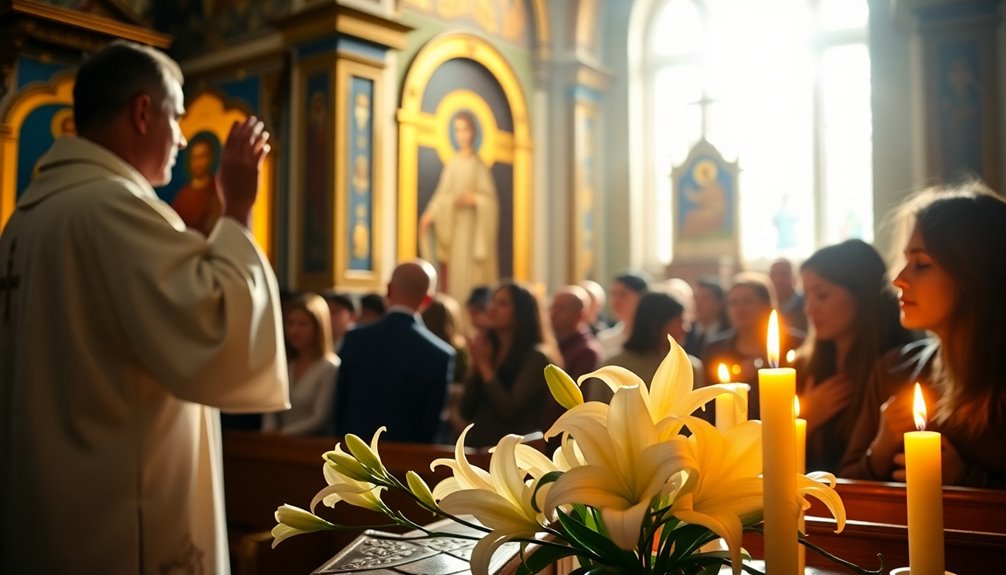
In the Orthodox tradition, the importance of blessings permeates every aspect of life, intertwining the sacred with the mundane. Blessings act as intercessory prayers, inviting divine intervention and highlighting the synergistic relationship between you and God. They affirm that even material objects can become holy, guiding your life towards the divine. By integrating blessings into daily routines, you're reminded that nothing is disconnected from God. Each blessing serves as a witness to His presence, fostering community and shared faith. Furthermore, blessings reflect the belief that Saints are alive in Christ and can intercede for us, demonstrating the power of intercessory prayer. Whether it's dedicating a new home or marking significant life events, these sacred rituals express gratitude for life's gifts, reinforcing that all good things originate from and lead back to God's love and concern.
Rituals and Their Meanings
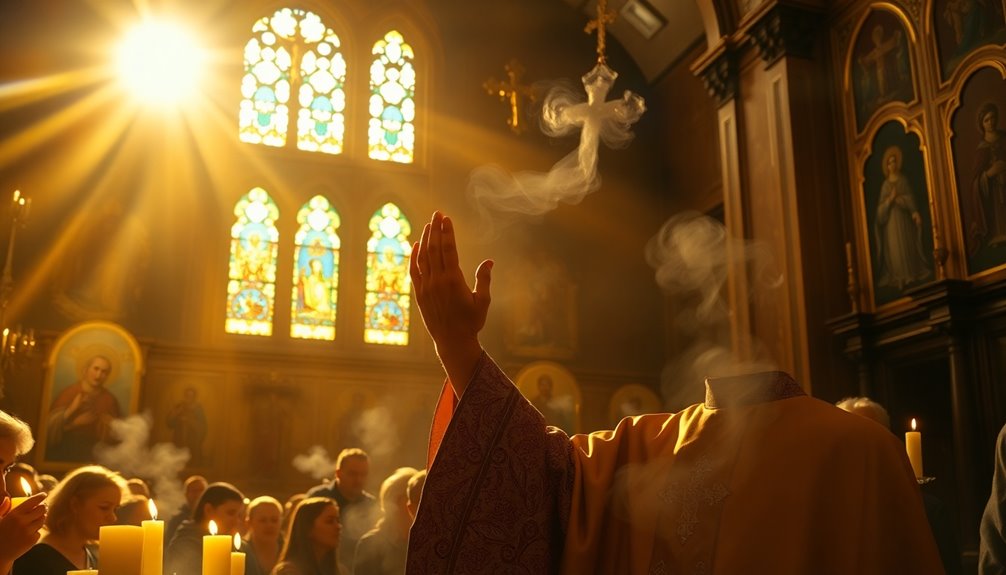
Rituals play an essential role in expressing faith and connecting with the divine, as they embody the traditions and beliefs that shape the Orthodox experience.
When you participate in blessing ceremonies, a bishop or priest invokes God's name, often signing your head with the cross. You may approach with cupped hands, seeking individual blessings for yourself or your loved ones.
Events like trips or the blessing of homes with holy water highlight God's presence in daily life. The Orthodox tradition emphasizes that these blessings are administered by sacramental leaders who hold the authority to invoke divine favor.
Special rituals, such as the Great Blessing of the Waters during Theophany, symbolize spiritual renewal and the sanctification of nature. These ceremonies not only reinforce the community’s faith but also foster a deep connection to the natural world. As participants gather at the riverbank, the waters are blessed, symbolizing the cleansing of both spirit and environment. In the backdrop, the hacienda style home features beautifully carved wooden beams and vibrant terracotta tiles, blending architectural elegance with the serene landscape that surrounds them.
Through these rituals, you affirm that every aspect of life is intertwined with the sacred, inviting divine grace into your journey.
Role of Iconography in Blessings
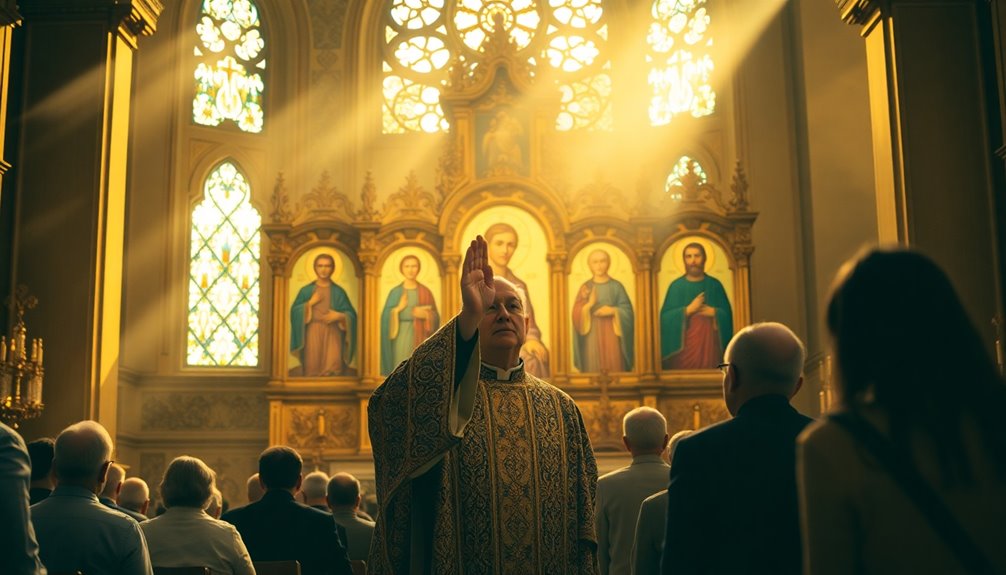
While participating in Orthodox blessings, you may notice how integral iconography is to the experience. Icons serve as windows to heaven, manifesting the divine presence of Christ, the Virgin Mary, and the saints. When you gaze upon these sacred images, you establish a spiritual connection, allowing God's grace to flow into your life. The creation of icons is considered a sacramental act, reflecting the deep spiritual preparation of the iconographer before beginning their work.
Veneration practices, like kissing or lighting candles before icons, express your devotion and enhance the blessing experience. Priests or bishops often bless icons, affirming their sanctity within the tradition.
These visual representations act as catechetical tools, teaching essential theological concepts. Ultimately, icons deepen your understanding of faith, helping you participate more fully in the blessings of the Orthodox Church.
Historical Context and Evolution
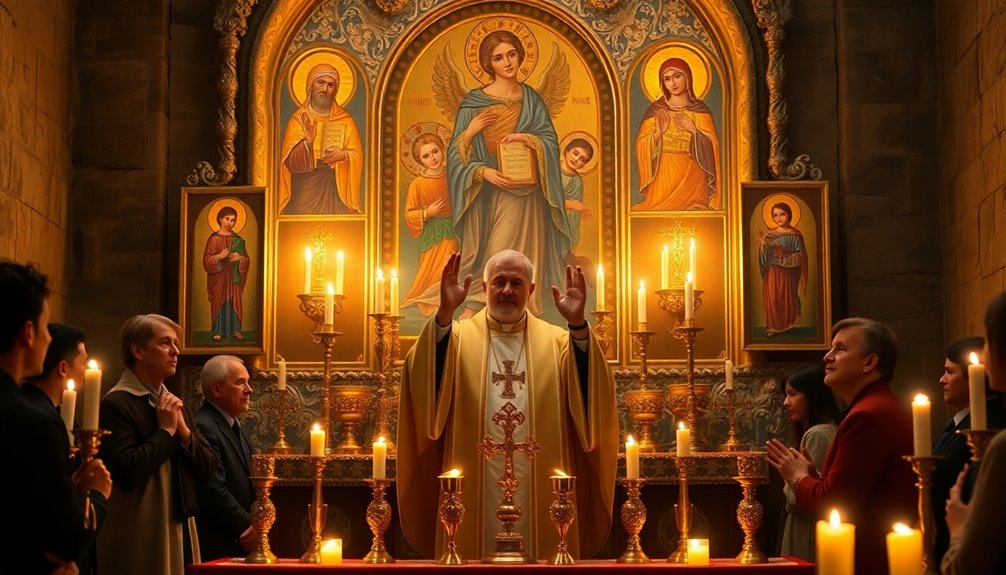
Understanding the historical context and evolution of Orthodox blessings reveals how deeply rooted these practices are in the early Christian tradition.
You'll find that the Christianization of Old English transformed the meaning of "bless" from a pagan connotation to a sacred act aligned with Christian values.
By the sixth century, liturgical practices had considerably developed, with key prayers and rituals integrated into the Liturgy. The establishment of five Patriarchates guaranteed the transmission of teachings from the Apostles to bishops, maintaining the continuity of faith.
The Byzantine influence and subsequent schisms, particularly the Great Schism of the 11th century, further shaped Orthodox blessings, reflecting diverse historical conditions.
Each of these elements contributes to the richness and depth of Orthodox blessings today.
Frequently Asked Questions
Can Anyone Perform an Orthodox Blessing?
Yes, anyone can perform an Orthodox blessing, especially in informal settings.
If there's no priest or bishop around, you can bless food by saying a prayer and making the sign of the Cross. Just remember to use the same gesture you'd employ when blessing yourself.
However, when clergy are present, it's respectful to defer to their authority for blessings.
This practice helps connect everyday moments with your faith.
How Often Are House Blessings Conducted?
House blessings are typically conducted yearly in the Eastern Orthodox tradition, usually from Theophany until Lent begins.
Copts prefer to bless a house only once, generally when someone moves in.
While it's best to schedule blessings during this timeframe, you can have your house blessed at any time.
Check with your parish for specific scheduling methods, like sign-up lists or emails, to arrange a convenient time for your blessing.
What Are the Specific Prayers Used in Blessings?
In the spirit of sacred traditions, you'll find specific prayers integral to blessings.
For instance, the Trisagion Prayer invokes the Holy Trinity, seeking divine mercy and healing. Before meals, you recite a prayer acknowledging God's provision, while the prayer after meals expresses gratitude for earthly blessings.
There are also blessings for icons, churches, food, and various objects, each reminding you that all good things originate from God.
Are Orthodox Blessings Exclusive to the Eastern Orthodox Church?
No, Orthodox blessings aren't exclusive to the Eastern Orthodox Church.
While their practices are deeply rooted in Eastern traditions, some Western Rite Orthodox congregations also perform similar blessings.
You'll find that other Christian denominations, like the Coptic Church, have their own forms of blessings, albeit with different rituals.
Ultimately, the essence of blessings transcends specific traditions, focusing on affirming God's presence in various aspects of life across different communities.
How Do Blessings Affect Personal Spiritual Life?
You might've noticed how blessings can transform your spiritual life. They deepen your connection with God, encouraging regular prayer and mindfulness.
When you participate in blessings, you not only receive guidance but also strengthen community bonds. This communal aspect nurtures virtues like gratitude and compassion, helping you grow spiritually.
As you engage in these practices, you cultivate a sense of purpose and experience moments of renewal that enrich your daily existence.
Conclusion
In the tapestry of Orthodox tradition, blessings weave a thread of divine connection that transcends time. Each blessing, like a gentle breeze, carries the weight of history and the warmth of community, inviting you to partake in sacred rituals. As you embrace these moments, remember that blessings aren't just words; they're echoes of faith and love, illuminating your path. So, let these sacred traditions guide you, wrapping you in their comforting embrace, as you journey through life.
